|
|
Why Eat Rabbit Meat?
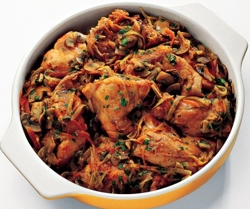
|
Domestic rabbit has a delicate flavor, comparable to chicken
in taste, but not identical. The ratio of meat to bone is
high meaning there is more edible meat on the carcass than
even a chicken. It contains more protein, than beef, pork
and lamb, and at the same time only has a small amount of
fat. Because rabbit meat has almost no
“saturated” fat, even people who have serious
problems with the gastrointestinal tract, may eat it.
Rabbit meat is one of the best “white meats”
available on the market today. Besides protein, it contains
vitamins and minerals, such as vitamins B and C, potassium,
iron, phosphorus, and trace minerals. But it has a minimal
amount of sodium salts, that makes it an important dietetic
product. It is common for rabbit meat to be used in special
diets for the aged, for heart disease patients, low sodium
diets, etc.
|
Rabbit meat is so healthy and lean that doctors prescribe
rabbit meat diets to people who are overweight and obese.
Because the fat and calorie levels are so low, but protein so
high, one can radically change their life by eating a rabbit
meat diet and exercising.
Regular consumption of rabbit meat normalizes metabolism.
Large amount of lecithin, and a small amount of cholesterol
in rabbit meat makes it an excellent remedy that helps to
prevent atherosclerosis.
Studies have shown that rabbit meat is an excellent food in a
unique way, that it doesn’t allow radioactive strontium
to penetrate into the body. It turns out that eating rabbit
meat reduces the dose of radiation received. Thanks to this
amazing property, it is recommended for cancer patients to
eat rabbit meat to reduce the harm, caused by anti-cancer
therapies.
It is also noteworthy that the protein in rabbit meat is
almost entirely assimilated by our body ( 96%). Breast-
feeding moms, school-age children and the elderly people do
well on this protein. The fat of rabbit meat is a bio-active
substance, and has anti-allergic properties. Even toddlers
are allowed to eat rabbit meat because it contains a minimal
number of allergens.
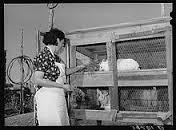 A
Little History....
A
Little History....
Rabbits, especially the European rabbits have been used for
meat as far back as 1500BC.
The first recorded rabbitry was in early Roman times, where
rabbits were kept in walled rabbit gardens for food.
Our forefathers, whether Native American or Pioneer Settlers,
ate rabbit meat. Without refrigeration, there was no worry
of wasted meat, unlike bison or deer.
Back in the 1940s and 1950s rabbit meat was as common for
dinner as chicken is today. It is the meat that got many
people and their children through the lean times of the
Depression. Rabbit meat began to lose its popularity though,
as Big-AGRA’s giant feed-lot and factory farm
operations started supplying lots of cheap, sub-quality
chicken and beef.
In other countries many people enjoy rabbit meat with France
being the world’s largest producer and consumer of
rabbit meat. In Hungary, there are rabbit producers with
over 10,000 does that produce rabbits for export to Italy.
Actually today, you will find rabbit as a gourmet delicacy on
the menu in many “high-end” restaurants on the
East and West coasts. It is also quite popular in some
Southern States.
When rabbit meat is on the menu though, you can expect
controversy to follow. While it’s perfectly acceptable
to eat farm animals such as cows and chickens, many people
balk at the idea of eating “cute little bunnies”.
Despite the resistance to consuming rabbits, this lean meat
serves as a healthful and nutritious alternative to chicken,
beef and pork. The office of home economics, state relations
of the U S Department of Agriculture have stated that
domestic rabbit is one of the most nutritious meats known to
man.
|
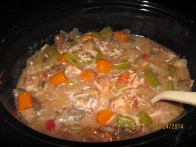 Specific Health Benefits....
Specific Health Benefits....
Calories.... A serving of
rabbit meat contains far fewer calories than the same size
portion of other meats. For example, rabbit has only 795
calories per pound... as compared to: Chicken-810, Veal-840,
Turkey-1190, Lamb-1420, Beef-1440, Pork-2050.
Fat and Cholesterol.... Rabbit
meat is lower in percentage of fat than chicken, turkey,
beef, or pork. Also, the fat is on the outside of the meat
like a deer and not as laced or marbled in the meat like
beef. The amount of cholesterol in rabbit meat is also much
lower than chicken, turkey, beef or pork, making it very
“heart-patient” friendly.
Protein.... Rabbit meat has a
high amount of easily digestible protein, and the highest
protein percentage of all other meats.
Vitamins... Adding rabbit meat
to your meal plan gives you a big boost of vitamin B-12. One
3 oz. serving will provide more than the minimum daily
requirement. Vitamin B-12 plays a critical role in the
function of your central nervous system and metabolism, as
well as the formation of red blood cells.
Rabbit also serves as a rich source of vitamin B-3 (niacin).
This vitamin aids in converting carbohydrates to energy and
manufacturing a variety of hormones.
Minerals... Rabbit meat
contains quite a bit of selenium, a mineral your body uses to
make antioxidants which help to combat hardening of the
arteries, as well as cancers such as stomach, lung, prostate
and skin cancer.
A serving of rabbit also provides you with a good amount of
the phosphorus you need in your daily diet. This mineral
influences your body’s ability to use carbohydrates and
fats, as well as to repair cells, tissues and bone
metabolism.
The calcium and phosphorus contents in rabbit meat are higher
than other meats, but the sodium content is comparatively
less.
So as you can see there are many
health benefits to eating rabbit meat. Use rabbit as a
replacement for chicken in any recipe. Because rabbit is
such a lean meat, some recipes call for cooking at lower
temperatures for a longer time, adding other fats, or
marinating first. Give it a try!
|
 Other
Interesting Facts....
Other
Interesting Facts....
- Rabbits are one of the most productive domestic
livestock animal there is.
- While feeding off its mother’s milk, a
new born rabbit can double its weight in just 6 days... as
compared to a pig at 14 days, calves 47 days, and humans 160
days.
- One rabbit that weighs 10 pounds, can produce
300 pounds of meat in a year!
- Rabbits can produce 6 times the meat that a cow
can produce on the same amount of feed and water.
- Because rabbits can be bred year ’round,
the meat is usually available almost anytime of the year.
- Rabbit meat is considered kosher, halal and
acceptable for Hindus who decline beef for religious reasons.
The Catholic Church's restriction on eating meat during Lent
does not apply to rabbit meat.
- Rabbits can eat a grain-free diet. They are
rarely ever fed anything medicated, and are not treated with
hormonal growth stimulants and antibiotics like chicken and
beef.
|
|
Rabbit Meat for Dogs and Cats....
Rabbit would have to be one of the most suitable all round
meat sources for both dogs and cats. Wild rabbit is a free
range, organic meat, low in fat, and high in nutritional
value. It is an ideally suited prey source, and has
historically been a favorite prey animal of both dogs and
cats.
Rabbit is very hypoallergenic and can help with any animal
that has food or other intolerances to other meats. It is
also helpful in animals with dry flaky skin. A raw diet most
closely resembles the natural diet for carnivores like dogs
and cats.
|
 The future of rabbits....
The future of rabbits....
As the worlds human population grows there will be less land
and water to raise food. The rabbit will play an increasing
role in food production, due to the fact that rabbits can and
do grow well in smaller spaces.
Rabbits are being used as a solution for protein-energy
malnutrition in developing countries. The greatest plus is
that rabbits can be raised on a grain-free diet. In a world
of rising prices and increasing demand for grain, the ability
to raise a good protein on garden forage is critical in
poorer countries.
Following the catastrophic 2010 earthquake, many Haitians
moved out of their devastated capital and back into the
countryside, relying on small holdings to grow vegetables and
raise animals like rabbits. Over 1,700 Haitian rabbit
producers now maintain some 1,250 rabbit facilities, which
are home to 32,650 breeding rabbits.
|
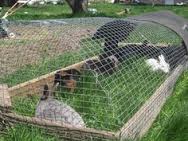 Reasons To Raise Backyard Rabbit For Meat...
Reasons To Raise Backyard Rabbit For Meat...
We are all concerned about our health (or at least we should
be!) and one great thing about raising your own rabbit meat
is not only that you’ll know exactly what has gone into
your rabbit, but you’ll also be eating a leaner
protein-rich diet. Pound-for-pound, rabbit meat has FAR MORE
protein and LESS fat than other meats. This means
you’ll not only be spending less for food, but
you’ll have the extra health benefit too!
You may have been considering raising chickens, geese, ducks,
goats, sheep or other small livestock for meat, but once you
learn how easy and inexpensive it is to raise rabbits, you
may just consider rabbits for your primary meat source.
Here’s why....
Rabbits have an extremely high reproduction
rate. One healthy, mature doe can produce up
to 1000% of her body weight every year. Owning just one
female and one male can supply meat twice a week for a family
of four.
Rabbits need very little living space.
Whether you’re living in a condo or out in the country, you
can always find space to raise a couple rabbits. No grazing
is required and they’re rarely classified as livestock
which allows you to keep them virtually anywhere. How many
apartment complexes would let you keep a chicken or goat in
them?
Rabbits are low maintenance. Check in on them
every evening to feed, water and do quick health checks,
clean their cages once a month and keep a simple breeding
journal... that’s all you need to do! Females take care
of the young themselves and the only special tools
you’ll need are nesting boxes which you can even build
yourself. No incubators or hand feeding is required.
Rabbits don’t need a heated barn. Most
meat rabbit breeds can withstand cold weather down to -20 as
long as they have hay or straw to burrow in, with appropriate
shelter from the extreme weather, wind, snow etc. But keep
in mind you will need to keep your rabbits cool in the summer
heat. Depending on your breed type, you'll want to keep your
rabbits at least below 80 degrees F but it would be better at 70 degrees F or
lower.
Rabbits are virtually silent roommates.
Rabbits are extremely quiet animals. They won’t reveal
your location to anyone, even if you’re traveling with
them. Who knows what a chicken, goose or duck is likely to
attract, not to mention a rooster. If outdoor cages are well
hidden and clean, neighbors may not even know they are there.
A little rabbit feed goes a long way. When
bunnies are being weaned (6-8 weeks old), they are large
enough for consumption. This allows you to skip giving most
of the bunnies feed as you gradually cull the young, leaving
only the adults to consume expensive rabbit feed.
Rabbits are the perfect sized meal for a family of
four. Rabbits are compact and usually
butchered at “fryer size” (3-5 pounds), so you
don’t have to worry about storing or eating leftovers.
Rabbit manure is great for your garden.
Rabbit manure is an excellent fertilizer that can be put
directly around your plants and does not need composted first
like chicken manure. Plus, if you do vermi-compost, your
worms can be fed the droppings too.
Rabbit meat is very high in protein and extremely low
in fat and cholesterol. Very few other meats
have nutritional values like rabbits, and none of them can be
raised in your living room. Doctors have actually been known
to prescribe rabbit meat diets to overweight patients.
Rabbit fur will make an incredibly warm coat and is a
great bartering item. On a cold
winter’s night, snuggling into a blanket made from
rabbit pelts will keep your family warm long after the fire
has gone out. You can also make hats or other accessories,
and kids love getting a lucky rabbit’s foot.
Rabbits are relatively easy to butcher and
clean. No one likes doing it but if you’re
going to eat them, they day will come eventually. Someone
with experience can take a rabbit from cage to freezer in 15
minutes or less. No plucking is needed and there’s
very little cleanup.
|
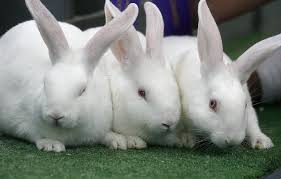 Food Security for Uncertain Times...
Food Security for Uncertain Times...
We are all aware of the current problems in world food
chains... pesticide contamination, GMO foods, herbicide
treated foods, depleted nutritional values, outbreaks of
disease, and more. You keep spending hard-earned money from
your pocket for sub-par food. So ask yourself a few
questions right now about the meat you put in your mouth
every day:
-
Would you like to know exactly where the meat you are eating
came from and what happened to it during its lifetime?
-
Would you like to fully control the animal’s diet and
whether it truly was fed organic, non-GMO feed and the best
other foods possible, instead of just being pumped full of
chemicals?
-
Would you like to be certain that it lived in a pen that was
cleaned regularly, where it lived a comfortable, content life
and was culled humanely?
-
Would you like to provide your family with warm clothing as
well as put food on the table?
-
Would you like to have meat, fur, rabbits and more to sell,
trade or barter?
All that and more is possible if you begin raising your own
rabbits for meat. Rabbits are quiet, clean and docile
creatures which can even be raised in your home. Even most
apartment dwellers can find enough space to raise a few
rabbits and neighbors may never even know they are there.
People have been raising meat rabbits for centuries but
breeding rabbits for meat and fur production didn’t become
popular in the United States until the beginning of the 20th
century. During the Great Depression, many families began
raising rabbits for food to avoid starvation and provide a
significant source of protein. Despite only feeding the
rabbits table scraps and foraged greens, a family could still
have decent rabbit meat production numbers although the
rabbits were not at their ultimate protein levels.
Food prices have been rising and are expected to rise even
more this year. Do you want to keep giving your money to big
business or would you rather keep it at home where it
belongs? There is no better time to take control of your own
food supply chain and to being raising meat rabbits in
addition to growing your own vegetables and fruits. Just a
few minutes out of every evening are enough to keep your
rabbitry running smoothly.
|
|
|
